UP Board Notes For Class 10 Science Chapter 16 Pollution Learning Objectives
After completing this chapter, you will be able to:
- Define pollution and differentiate between pollution and pollutant;
- Classify materials into biodegradable and non-biodegradable;
- List various types f pollution – air, water, soil, radiation and noise;
- Describe the sources, effects and control of air, water, soil, noise and radioactive pollution;
- Explain the cause and effect of global warming, acid rain and ozone layer depletion;
- Describe the effect f pollution on climate, environment, human health and other organisms and its abatement.
Environment (derived from the French word environ meaning to encircle or surround) can be defined as the physical and biological world where we live. We depend on our environment, both for our natural and technological needs.
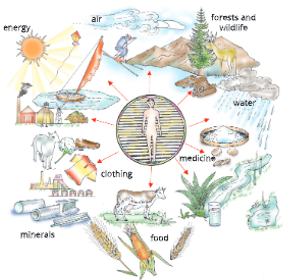
UP Board Notes For Class 10 Science Chapter 16 Pollution Environment has three major components.
1. Physical surroundings: These include the air that we breathe, the water that we drink and the soil (land) on which we live. The physical components together contain nutrients like oxygen, carbon dioxide, nitrogen, mineral salts, water and many other substances.
2. Living organisms: These constitute the biotic environment, that is, plants and animals including humans and microorganisms like bacteria and fungi.
3. Climatic factors or meteorological components: These constitute another part of the physical environment and include sunlight, temperature, rainfall, humidity, pressure, wind speed, etc.
| Class 10 Science | Class 11 Chemistry |
| Class 11 Chemistry | Transformation of Sentences |
| Class 8 Maths | Class 8 Science |
Overpopulation, urbanization and industrialization have contributed in various ways in the deterioration of the environment. It has resulted in the depletion of natural resources and disturbance of the ecological balance. This general deterioration of the environment has resulted in environmental pollution.
UP Board Notes For Class 10 Science Chapter 16 Pollution And Pollutants
Pollution can be defined as an undesirable change in the physical, chemical and biological characteristics of our surroundings, which adversely affects the natural quality of the environment, human life and other living beings.
Pollution can be natural or man-made. The substances that cause such changes (pollution) are called pollutants.
Pollutants can be categorized as follows:
1. According to source: Natural sources such as volcanic ash, forest fire, dust from storm, pollen grains in air and decay of organic matter. Man-made sources such as water from industries, motor transport emissions, oil from furnaces, sewage waste, fertilizers and pesticides, etc.
2. According to biodegradability: Pollutants can be biodegradable and non-biodegradable depending on their degradation into simpler substances by biological agents.
Air pollution
Air pollution can be defined as the occurrence or addition of foreign particles, gases and other materials into the air, which adversely affect the biological communities (human beings, plants, and animals) and physical surroundings (roads, buildings).
The World Health Organization (WHO) has defined air pollution as befouling the air by human activities to such an extent, that it is sufficient to cause harmful effects on the health, vegetation and property.
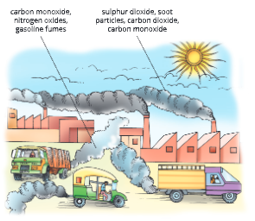
Sources of air pollution
There are two sources of air pollution – natural and man-made.
Natural sources
- Forest fires, ash from smoking volcanoes, dust from torm, decay of organic matter
- Pollen grains floating in air
UP Board Notes For Class 10 Science Chapter 16 Pollution Man-made Sources
- Transportation: Motor transport and internal combustion engines that burn petrol, diesel, kerosene, etc., which causes release of carbon monoxide, hydrocarbons and nitrogen oxides
- Fuel combustion: Industrial plants and power stations using coal or crude oil
- Burning of vegetable oils, kerosene and coal in households
- Furnaces using coal, cow dung cakes, firewood, kerosene, etc.
- Burning of garbage and dust from brick kilns
Air pollutants
The air pollutants may be grouped under two categories.
1. Particulate air pollutants: The particulate air pollutants include solid particles suspended in air, smoke, soot, aerosols, dust and mists. They also include dust of cement, brick kilns, glass, ceramics and aerosols. Particles given off in the manufacture of metal items, cotton dust from textile industries and even pollen grains are also particulate air pollutants.
2. Gaseous air pollutants: These include smoke given out from burning of coal, firewood, cow dung cakes, kerosene oil, etc. and also from cigarettes, Biri, cigars and other tobacco products. Some of the important air pollutants are discussed
below.
Carbon dioxide
Carbon dioxide is one of the natural gases present in the atmosphere and is used by plants for photosynthesis. It is chiefly produced during the combustion of fossil fuels in households, factories, power stations, etc. The increasing content of CO₂ in the atmosphere is likely to have the following effects.
- A rise in atmospheric temperature due to greenhouse effect would cause a decrease in the precipitation and soil moisture content.
- More CO₂ will dissolve in water and the water in the oceans would be more acidic. This will
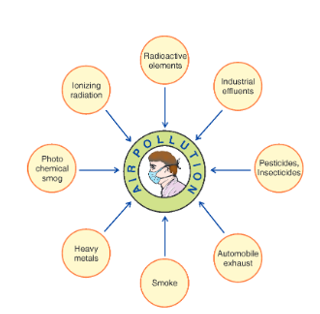
lead to reduced productivity of the marine ecosystem.
- The rise in temperature due to more CO₂ would cause melting of continental and mountain glaciers, leading to flooding of coastal areas of some countries.
UP Board Notes For Class 10 Science Chapter 16 Pollution Greenhouse Effect
Atmospheric concentrations of carbon dioxide, water, ozone, methane, nitrous oxide and chlorofluorocarbons. are key role players in maintaining the global temperature. Collectively, these gases act somewhat like a pane of glass in a greenhouse.
These impede the escape of longer, infrared wavelengths (heat) from the earth into the space. Thus, heat builds up in the lower atmosphere. This is called greenhouse effect.
- In greenhouse effect, the greenhouse gases such as CO₂ and methane, produced by burning of fossil fuel, agriculture and deforestation trap heat radiated from earth and lead to increase in the earth’s temperature.
- Rays of sunlight penetrate the lower atmosphere and warm the earth’s surface.
- The earth’s surface radiates heat (infrared wavelengths) to the lower atmosphere. But greenhouse gases and water vapour absorb these infrared wavelengths and reradiate a portion back towards the earth.
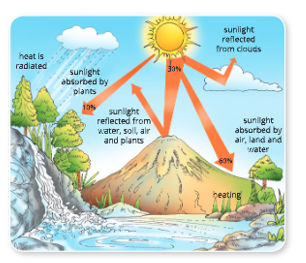
- As the concentration of greenhouse gases increases in the atmosphere, the surface temperature of the oceans rises, more water evaporates into the atmosphere, and the earth’s surface temperature also rises.
An increase in the temperature of the atmosphere might cause sea levels to rise. Temperature near the ocean surface would increase and make glaciers and the polar ice sheets melt faster. This would flood the low-lying coastal regions like Bangladesh, Lakshadweep and the Andaman and Nicobar islands.
Carbon monoxide
- It is produced as a result of incomplete combustion of fossil fuels like coal, petroleum and wood charcoal. Automobiles using diesel and petroleum are the major sources of carbon monoxide.
- Carbon monoxide is more dangerous than carbon dioxide. It is a poisonous gas leading to respiratory problems. When it reaches the blood stream, due to its high affinity for haemoglobin, it replaces oxygen, and reduces oxygen carrying capacity of the blood. It also causes giddiness, headache and heart disease. In much higher concentration it can also cause death.
Sulphur dioxide
It is produced by the burning of coal in powerhouses and automobiles. It is mainly absorbed by water and goes into the soil as sulphuric acid. It causes chlorosis and necrosis of vegetation, irritation in eyes, asthma and bronchitis. It is also responsible for discolouration and deterioration of buildings, fabrics, leather, etc. and causes acid rain.
UP Board Notes For Class 10 Science Chapter 16 Pollution Acid Rain
- Emissions of sulphur dioxide and oxides of nitrogen from power stations, factories and motor vehicles cause the formation of sulphuric and nitric acids in rain clouds. If rain falls through polluted air, it picks up more of these gases and increases its acidity. This is called acid rain.
- Effects of acid rain: Damage to plants: Acid rain causes progressive death of young shoots; leaves turn yellow and fall off; fine root structure is damaged; and the whole tree eventually dies.

- Damage to soil: Acid rainmay make the soil more acidic. damaged by acid rain It may cause mineral nutrients to be washed away. It may help to release toxic chemicals, such as aluminium and mercury into the soil. Thus, acid rain changes soil salinity, which make soil less fertile.
- Damage to freshwater life: Fish may be killed when acidity releases aluminium into the water. This builds up as a layer of aluminium hydroxide in the gills of fishes.
Can acid rain be reduced?
There are several ways in which sulphur dioxide emissions can be reduced.
- Coal can be crushed and washed before burning.
- Oil can be treated to remove sulphur.
- Cleaning systems can be fitted into chimneys to remove sulphur dioxide before it can be released. into the atmosphere.
- Furnaces that burn fuel more effectively and produce less pollution can be used.
- Vehicle exhausts can be fitted in vehicles, which remove pollutants from engine emissions.
Smog
Smog is a mixture of smoke, dust particles and small droplets of fog. Smog may cause necrosis and develop a white coating on the leaves (silvering) of plants. In human beings and animals, it may cause asthma and allergies.
Hydrocarbons
Hydrocarbons are produced due the to incomplete combustion of burnt fuel. The most prominent hydrocarbon in air is methane (CH₂). Hydrocarbon is a cause of smog and cause skin cancer, irritation in eyes and respiratory system.
Aerosol spray propellants
The suspended fine particles in the air are known as aerosols. It is a group of chemicals, which are released into the air with force in the form of vapour or fine mist. Aerosols contain chlorofluorocarbons (CFCs) and fluorocarbons which cause depletion of the ozone layer.
Oxides of nitrogen
A few oxides of nitrogen, such as nitric oxide (NO), nitrous oxide (N₂O) and nitrogen dioxide (NO₂) are important air pollutants. Oxides of nitrogen are produced by natural processes as well as released from thermal power stations, factories, automobiles and aircrafts (due to the burning of coal and petroleum). They reduce the oxygen carrying capacity of blood, may cause irritation in eyes and skin cancer in human beings.
Pesticides
Extensive use of pesticides pollute the environment as they are not biodegradable. For example, DDT that gradually accumulates in the cells and tissues of plants is harmful to animals as well as human beings.
Peroxyacetyl nitrate (PAN)
- PAN is formed due to the photochemical reaction of nitrogen oxides and hydrocarbons. In human beings, it causes stinging of eyes, cough, headache, pulmonary congestion, haemorrhage, dry throat, breathing problems and early ageing of the lung tissues.
- Air pollution from brick kilns Brick is one of the most important building materials in our country. Brick preparation consists of clay preparation, shaping, drying and firing operations. The burning of fuel for firing bricks results in the emissions of gaseous pollutants and ash into the atmosphere. Some of the air pollutants that are produced from brick kilns are:
- carbon dioxide and sulphur dioxide due to the burning of coal and wood.
- Suspended Particulate Matter (SPM) generated due to the incomplete combustion of fuel or released from fine coal dust and ash,
- hydrocarbons and carbon monoxide due to incomplete combustion of fuel.
- dust and fly ash.
These pollutants causes irritation of skin and eyes, and their inhalation causes pulmonary diseases such as silicosis. Pollution due to brick kilns also affects agricultural crops and fruit plantations.
UP Board Notes For Class 10 Science Chapter 16 Pollution Effects Of Air Pollution On Human Health
- Carbon monoxide combines with the haemoglobin molecules in human blood and causes suffocation.
- Depletion of ozone layer due to CFCs causes skin cancer as a result of over exposure of the human skin to UV rays.
- Sulphur dioxide originated smog blocks the human respiratory system leading to the death of the sufferer.
- Sulphur dioxide pollution also causes diseases of the eyes, throat, nose and lung infections.
- Sulphur dioxide pollution also causes acid rain, which pollutes the water, and thus, affects the health of persons consuming such polluted water.
- Nitric oxide (NO) in high concentration causes respiratory problems, gum inflammation, internal bleeding, oxygen deficiency, pneumonia and lung cancer.
- Air pollutants like SPM cause asthma, lung cancer and asbestosis.
- Some pesticides like DDT (Dichloro-diphenyl- trichloro ethane) are very toxic. When these pesticides enter our food chain and accumulate in our body (a process known as biomagnification), cause kidney disorders and brain and circulatory system-related disorders.
- Sudden leakage of poisonous gases from factories and chemical plants kills hundreds of people and livestock. The Bhopal gas tragedy of December 1984 is a burning example of such a deadly disaster. The leakage of methyl isocyanate (MIC) gas from the Union Carbide factory claimed thousands of animal and human lives in Bhopal.
Table summarizes the sources and effects of some major air pollutants on human health.
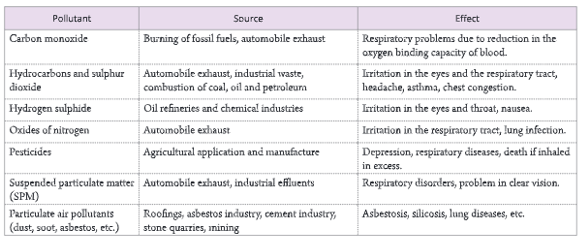
UP Board Notes For Class 10 Science Chapter 16 Pollution Occupational Hazards
There are many diseases that are related to our occupation. These diseases are known as occupational hazards. Some of these diseases are given below.
- Silicosis or Silicotuberculosis: This disease is caused due to the inhalation of free silica or silicon dioxide (SiO₂) while working in industries related to pottery, ceramic, glass, mining, building and construction work. The persons suffering from these diseases get chronic coughs and pain in the chest.
- Byssinosis: This disease occurs due to the inhalation of cotton fibres over a long period of time. The person suffering from this disease experiences chronic cough and chronic bronchitis.
- Asbestosis: This disease is caused due to inhaling asbestos powder used in making ceilings. Asbestos also causes cancer.
UP Board Notes For Class 10 Science Chapter 16 Pollution Effects Of Air Pollution On weather And Climate
- Depletion of ozone layer caused by CFCs may change the radiation balance at global level. This may result in an increase in the UV radiation reaching the earth’s surface and, therefore, could lead to a rise in the air temperature (global warming). Global warming would cause melting of continental glaciers and ice caps. This would cause a rise in the sea level and consequent submergence of coastal lands and lowland countries.
- Increase in the concentration of CO₂ and other Ozone layer depletion What are the ill effects of ozone layer depletion? greenhouse gases would cause greenhouse effect. This would lead to an increase in temperature and result in climatic changes.
- When smog is mixed with air pollutants causes deadly health hazards to humans, low visibility and increased road accidents.
- Acid rain due to SO₂ destroys and defaces buildings, sculptures and monuments resulting in damage to property and national heritage.
UP Board Notes For Class 10 Science Chapter 16 Pollution Methods of Controlling Air Pollutants
- Combustion: This technique is used for controlling those air pollutants that are in the form of organic gases or vapour. In this technique, organic pollutants are converted into less harmful products such as CO₂ and water vapour.
- Absorption: In this technique, gaseous pollutants are passed through absorbing material like scrubbers. These scrubbers contain a liquid absorbent. This absorbent modifies or removes one or more of the pollutants present in gaseous effluents. Thus, the air coming into scrubber become free from pollutants and it is then discharged into atmosphere.
- Adsorption: In this technique, gaseous effluents are passed through porous solid adsorbent kept in suitable containers. The gaseous pollutants either stick or get adsorbed at the surface of the porous material and clean air passes through. The organic and inorganic constituents of gaseous effluents
UP Board Notes For Class 10 Science Chapter 16 Pollution Ozone Layer Depletion
What are the ill effects of ozone layer depletion?
Ill effects of ozone layer depletion are:
At ground level, ozone is a harmful pollutant that damages plants and building materials and is hazardous to human health. However, in the upper atmosphere, ozone is like a life cover that protects us by screening the dangerous ultraviolet (UV) rays of the sun.
Without the ozone layer shield, the organisms on the earth would be subjected to life-threatening radiation burns and genetic diseases. Do you know that a 1% loss of ozone in the stratosphere results in a 2% increase in UV rays reaching the earth’s surface.
This could result in about one million times increase in the human skin cancer worldwide if protective measures are not taken.

What causes ozone layer depletion?
Causes ozone layer depletion are:
The exceptionally cold temperature (-85 °C to -90 °C) in Antarctica plays a role in ozone layer depletion. Ozone and chlorine- containing molecules are absorbed on the surface of ice crystals at high altitudes in Antarctica.
In the presence of sun’s rays, these chlorine ions are liberated and destructive chemical reactions take place. We also release a variety of chlorine-containing molecules into the atmosphere.
The most important for ozone depletion are CFCS and halogen gases. CFCs are very stable molecules, thus, they persist for decades, even centuries, once released. When they diffuse into the atmosphere, the intense UV irradiation releases chlorine atoms that destroy ozone.
International Ozone Day is held on 16 September every year. are trapped at the interface of solid adsorbent by physical adsorption.
UP Board Notes For Class 10 Science Chapter 16 Pollution Methods to Control Particulate Air Pollutants
The particulate air pollutants such as dust, soot, fly ash, etc., can be controlled by using fabric filters, electrostatic precipitators, wet scrubbers and mechanical devices, etc. These are given below.
- Mechanical devices: The mechanical devices work either by gravity in which the particle settle down by gravitational force, or by sudden change in the direction of gas flow in which particles separate out due to greater momentum.
- Fabric filters: In this technique, gaseous emission containing dust, soot and fly ash is passed through porous fabric filters made of fabric (woven or filled fabric). The particles of pollutants present in the gas get trapped in this fabric and are collected in the filter and the gases free from the pollutant particles are discharged.
- Wet scrubbers: The wet scrubbers are used in chemical, metallurgical and mining industries. The wet scrubbers trap SO₂, NH3 and metal fumes in their tank and clean gases are discharged in the atmosphere.
- Electrostatic precipitators: An electrostatic precipitator is a device containing a chamber that induces an electric charge on the particles of polluted air. These particles are then attracted to the oppositely charged electrode and are deposited there. In this technique, a gas or air steam containing aerosols in the form of dust, mist or fumes, is passed between the two electrodes of the electrostatic precipitator. During this process, the aerosol particles get precipitated on the electrode.
In addition to this, air pollution may also be prevented and controlled by the following measures.
- Using better-designed equipment and smokeless fuels/hearths in industries and at home.
- Using environment-friendly fuels, such as compressed natural gas (CNG) in automobiles instead of petrol/diesel.
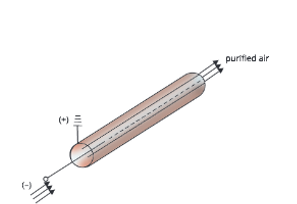
- Locating industries discharging heavy smoke and toxic fumes at places far away from human habitation.
- Planting more and more trees surrounding industrial establishments, along the roadside and in residential areas to reduce CO₂ level in the environment.
- Strictly adhering to emission-control standards for automobiles – BS-IV norms.
- Harnessing renewable energy resources, such as wind, solar energy and ocean currents, and minimizing the use of fossil fuels.
Euro-Bharat vehicular standards Euro-Bharat vehicular standards are instituted by the government of our country which regulates the output of air pollutants such as nitrogen oxides, carbon monoxide, hydrocarbon, particulate matter, soot and sulphur dioxide by motor vehicles.
In many cases they are similar to European emission standards, (Bharat Stage 1 equivalent to Euro I, BS II: Euro II, BS III: Euro III and BS IV: Euro IV). Since 1 April 2017, the Supreme Court of India has banned the sale of BS-III vehicles and BS-IV norms are now applicable across our country.
UP Board Notes For Class 10 Science Chapter 16 Pollution Water Pollution
Water pollution can be defined as a change in physical, chemical and biological properties of water by the addition of undesirable substances which may have harmful effects on human and aquatic life.

Sources of water pollution
Water pollution occurs due to its two sources –
1. Point sources: These sources discharge water pollutants directly into the water. For example, factories, power plants, underground coal mines,
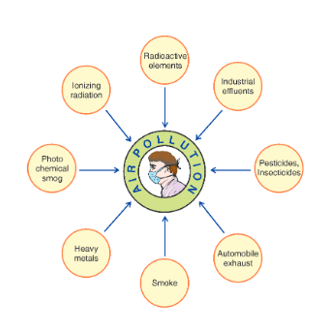
oil wells situated near water bodies, etc., are point sources of water pollution.
2. Non-point sources: These sources do not have any specific location for discharging pollutants in the water body. For example, run offs from field, lawns, gardens, construction sites, water-logged areas, roads and streets are some non-point sources of water pollution.
Pollution of freshwater
Freshwater is naturally occurring water on the earth’s surface in ponds, rivers, lakes and streams, and groundwater in underground streams. Freshwater has salt concentration of less than 1% and hence is not saline.
Pollution of freshwater is contamination by substances that make it unfit for natural or intended use such as drinking and washing purposes. Freshwater may be polluted in many ways, which are described as follows.
- Domestic sewage discharged into rivers without treatment. Phosphate and nitrate ions from excretory wastes of humans and animals pollute the water. This may cause diseases like typhoid, cholera, dysentery, etc., in the persons drinking such water.
- Organic wastes from agricultural fields along with phosphate and nitrogen fertilizers that reach lakes, rivers and sea (water becomes deoxygenated and poisonous, thus, cannot support aquatic life).
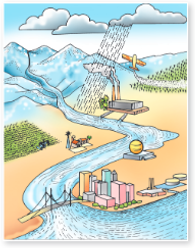
- Industrial wastes (effluents) from urban areas contain high concentrations of oil, heavy metals, synthetic detergents and alkalis.
- Pesticides, insecticides such as DDT and some industrial wastes containing mercury pollute the water and reach the food chain and ultimately in humans, affecting aquatic and human health.
UP Board Notes For Class 10 Science Chapter 16 Pollution Industrial Discharge
Industrial wastes contain harmful chemicals, oils, heavy metals, radioactive wastes and suspended solids which when discharged into water, make it poisonous. Since it is difficult to breakdown wastes, they affect the quality of water and pollute it.
Detergents
Inorganic pollutants like synthetic detergents, acids, salts and toxic metals contain compounds that make the water unfit for use and pollute it. Detergents primarily omprise phosphate, thereby increasing the phosphate levels in water, thus making it unfit for use.
UP Board Notes For Class 10 Science Chapter 16 Pollution Thermal Pollutants
Thermal pollution is the degradation of water quality by any process that changes the temperature of water. Thermal pollution is caused by the water which is used as a coolant by power plants, nuclear power plants and industries.
When this water (after cooling) returns to the natural streams, it is at a very high temperature, making it inappropriate for use. The change in temperature decreases oxygen supply, making it unfit for flora and fauna to survive. It also results in the growth of algae.
Radioactive pollutants
Radioactive materials enter the water through nuclear power plants, due to conducting nuclear tests and spillage from industries, and through mining of radioactive elements.
When radioactive substances enter the water bodies, especially seawater and oceans, they cause severe damage to the marine ecosystems and even cause gene mutation and other human diseases.
Marine pollution
Marine pollution is the contamination of oceans and seawater. The oceans and seawater mostly get polluted due to sewage, industrial waste, radioactive waste and oil spills.
UP Board Notes For Class 10 Science Chapter 16 Pollution Oil Spills
Oil pollution of oceans and rivers is caused due to spillage of oils from oil tankers, accidental spillage, refineries, offshore drilling and cleaning of fuel tanks of ships. On discharge, oil spreads on water and forms a layer of oil (oil slick). This is very harmful to aquatic life including fish, mammals and marine birds.
Effects of water pollution
- The presence of acids and alkalis in water destroys microorganisms, thereby hindering the self-purification process in rivers.
- Water pollution adversely affects aquatic life.
- The toxic materials may enter the food chain and cause serious health hazards in human beings and other aquatic animals.
- Polluted water causes epidemics, such as cholera, tuberculosis, jaundice, dysentery, typhoid and diarrhoea in human beings.
- The use of polluted water from lakes, ponds and rivers for irrigation of agricultural fields damages crops and decreases the agricultural production.
- Heavily polluted water affects the soil, decreases its fertility and kills soil microorganisms and even certain useful bacteria.
- The use of water contaminated with salts increases the alkalinity of the soil.
- Contamination of seawater due to oil slicks caused by the leakage of crude oil from oil tankers results in the death of sea organisms including fishes.
Prevention and control of water pollution
Some steps to reduce water pollution are listed below.
- Setting up sewage water treatment plants before its disposal into rivers.
- Using septic tanks in houses to avoid direct outlet of faecal matter and other wastes.
- Avoiding contamination of rivers, lakes and ponds by washing clothes, bathing, etc.
- Not throwing waste food materials, paper, biodegradable vegetables and plastic into open drains.
- Diverting effluents from distilleries and solid waste containing organic matter to biogas plants to generate energy.
- Treating industrial effluents before discharging into rivers, separate channels for river and sewage water.
- Totally baning on nuclear waste dumping in water.
- Generating public awareness about the maintenance of ponds, river, lakes and wells in rural and urban areas.
- Disposing of safely biomedical wastes like needles, syringes, soiled dressings, etc.
UP Board Notes For Class 10 Science Chapter 16 Pollution Soil Pollution
Any substance that reduces the productivity of soil is known as soil pollutant and the process, as soil pollution.
Causes of soil pollution
Soil pollution (also known as land pollution) is mainly caused due to the following reasons:
- Solid wastes (farm and animal manure)
- Agricultural wastes like plant remains, fertilizers, pesticides and other chemicals.
- Dead animal carcasses
- Industrial waste chemicals like fly ash and residues of combustion of solid fuels.
- Domestic garbage, paper pulp, plastic, rubber, cloth, leather, metal scrap and glass.
- Biomedical wastes such as used syringes, cotton pads, needles, dirty dressings and discarded biological research materials. When disposed of in the garbage pollutes soil and affects soil organisms.
Prevention and control of soil pollution
- Effluents from industries and factories should not be allowed to enter the soil indiscriminately.
- Drainage system should be so developed that the polluted water does not get mixed up with the soil.
- Proper toilet facilities should be provided to all and awareness should be created about the harmful effects of defecation in open places.
- Fertilizers, pesticides and insecticides should be used judiciously so that excess chemicals are not washed into the soil.
- Safe methods of disposal of domestic, agricultural and industrial solid wastes should be adopted.
UP Board Notes For Class 10 Science Chapter 16 Pollution Of Waste Materials Biodegradable And Non-biodegradable
We produce various kinds of waste materials due to our day-to-day activities. The waste materials can be broadly classified into two types – biodegradable wastematerials and non-biodegradable waste materials.
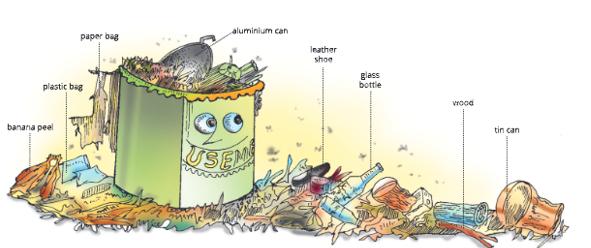
Biodegradable waste materials
- The waste materials that can be broken down or decomposed into simple substances in nature, by the action of microorganisms, such as bacteria, in due course of time are called biodegradable waste materials.
- The biodegradable waste decomposes naturally and becomes harmless to humans, and other environments after some time. For example, dead plants and animals (including bones), animal excreta (cattle dung, urine), leather goods, tea leaves, wool, paper, plant parts, hay and wood, cotton clothes, cardboard, seeds, grains and compost (manure made from decayed plants and vegetable stuff) are all biodegradable materials.
- For example, plastic, polythene bags, synthetic fibres, glass objects, metal articles like aluminium cans, silver foils, certain detergents, fertilizers, pesticides like DDT and radioactive wastes. For instance, DDT is a non-biodegradable waste. It cannot be degraded or decomposed into simple compounds by the action of microorganisms in nature. Thus, it gets accumulated in the environment and harms humans, other animals, and even vegetables and plants. Thus, DDT has been banned for use in most of the countries.
- gives a summary of the main differences between biodegradable and biodegradable wastes.
Recycling of biodegradable wastes
Some of the biodegradable wastes can be recycled to restore our natural resources and ecological balance. We may again use the products of recycled materials for our day-to-day activities.

UP Board Notes For Class 10 Science Chapter 16 Pollution Noise Pollution
Noise pollution can be defined as unwanted or offensive sounds that unreasonably affect our daily activities. The term noise is very subjective. Sometimes when you are concentrating on your work then even a mild conversation or whisper sound may become a noise.
On the other hand, if you are in light mood in a party, then even many people talking does not seem to be noise.
The unit of sound intensity measurement is decibel (dB). Decibel is the unit for measuring the relative loudness of sounds that human ears can normally detect.
Major sources of noise pollution
- Road traffic: Road traffic noise one of the most widespread and growing environmental problems.
- Air and rail traffic: In areas close to the airports and railway tracks, the sound of aeroplanes and trains are major sources of noise pollution.
- Neighbourhood and domestic noise: Barking dogs, car horns, loud music, TVs, loudspeakers, construction and household noise are some of the major sources of noise pollution.
- Noise from industries: At many places, industries are located in close proximity of the residential areas or within the residential areas. Sound of machines, etc., causes noise pollution.
Harmful effects of noise pollution
- Noise can affect human health and well-being in a number of ways, including annoyance reaction, sleep disturbance, interference with communication, performance effects, effects on social behaviour and hearing loss.
- Noise can cause annoyance and frustration as a result of interference, interruption and distraction.
- People experiencing high noise levels have increased incidences of headaches, greater susceptibility to minor accidents, increased reliance on sedatives and sleeping pills, and increased mental sickness.
- Exposure to noise is also associated with a range of possible physical effects including cold, changes in blood pressure, other cardiovascular changes,
- problems with the digestive system and general fatigue. Prolonged exposure to noise levels at or above 80 dB can cause deafness because of the damage to the organ of Corti in the internal ear.
How to control noise pollution?
The noise pollution can be minimized in following ways.
- Reduce the noise at its source in industries and automobiles, etc.
- Try not to put the TV on high volume. When playing music, turn it down at a reasonable level. Better use headphones if you want to play your music loud or late at night.
- Plant trees at roadsides; put curtains on the doors and windows; instal glass panes at the windows, etc., to interrupt the path of the noise. This will reduce the noise to some extent.
- Do not unnecessarily blow horns. This disturbs others.
- If the source of noise is unavoidable cover your ears by hands or use ear plugs to avoid noise.
UP Board Notes For Class 10 Science Chapter 16 Pollution due To Radiation
The radioactive substances are generated due to nuclear activities in nuclear reactors and nuclear power plants. The radiations from these radioactive substances harm human health and health of other flora and fauna. There are three types of radiations generated from nuclear activities.
1. Alpha particles that cannot penetrate human skin or a sheet of paper.
2. Gamma rays usually produced from cobalt source, which can penetrate human skin and harm body cells. Gamma rays are most harmful to human beings.
3. Beta rays that can penetrate skin but not glass and metal.
The source of radiation pollution are nuclear reactors, X-rays, nuclear power plants, radioisotopes,gamma chambers, radioactive ore mining.
Effects of radiation pollution
There are many effects of radiation pollution which may be short-term and long-term. The short-term effect may be skin burns and skin cancer. The long-term effect of radiation include gene damage by mutation in genes; and cancer of intestine, bone marrow, gonads and spleen. Radiation can also cause loss of immunity, loss of hair and chromosomal abnormalities.
UP Board Notes For Class 10 Science Chapter 16 Pollution Swachh Bharat Abhiyan -A mass Movement To Clean India
- Swachh Bharat Abhiyan is a campaign launched by the government of India to make India a clean and green country. It was officially launched by the Prime Minister of India on 2 October 2014 at Rajghat, New Delhi.
- It is India’s largest ever cleanlisness drive. One of the key objectives of Swachh Bharat Abhiyan is to reduce or eliminate open defecation by constructing toilets. The government’s objective was to make an Open Defecation Free (ODF) India by 2 October 2019, by constructing 12 million toilets in rural India.
The government has allocated special budget for Swachh Bharat Abhiyan. The railways is also planning to have facility of clean bed-rolls from automatic laundries, and bio-toilets etc., under this Abhiyan. The government has nominated key social personalities as ambassadors for this Abhiyan.
Swachh Survekshan
With an aim to foster a spirit of competition among the cities on cleanliness and assess their sanitation status, the government of India has started ranking cities on the basis of cleanliness surveys known as Swachh Survekshan. The performance of each city is evaluated on key parameters like
- sweeping, collection and disposal of wastes.
- open defecation free / availability of toilets.
- capacity building and e-learning. provision for public and community toilets.
- information dissemination and behavioural change. As per Swachh Survekshan 2017,
- Indore, Madhya Pradesh was ranked the top city on cleanliness. indicators.
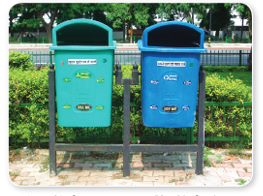
UP Board Notes For Class 10 Science Chapter 16 Pollution Summary
- An undesirable change in the physical, chemical and biological characteristics of our surroundings which harms the human life and other living beings is known
as pollution. - Air pollution may be defined as the occurrence of foreign particles, gases and other materials in air, which have adverse effects on biological communities and physical surroundings.
- Carbon monoxide, carbon dioxide, sulphur dioxide, fluorides, smog, aerosol spray propellants, oxides of nitrogen, suspended particulate matter, pesticides, and peroxyacetyl nitrate (PAN) are some common air pollutants.
- Water may be polluted by pesticides, chemicals, industrial and domestic wastes, mineral and organic wastes, and radiation wastes.
- Solid and agricultural wastes, dead animals’ carcasses, industrial wastes and domestic garbage cause soil pollution.
- The waste materials that can be broken down or decomposed into non-poisonous substances by the action of microorganisms are called biodegradable materials.
- The materials that cannot be decomposed to non-poisonous substances in nature by the action of microorganisms are called non-biodegradable waste materials.
- Unwanted or offensive sound that unreasonably affects our daily activities is called noise pollution.
- Radiations from radioactive substances cause radiation pollution.
